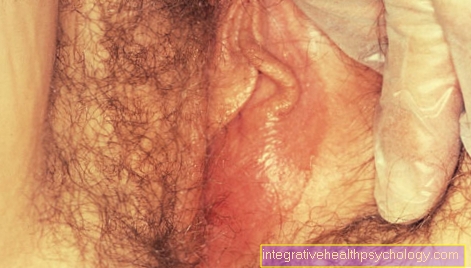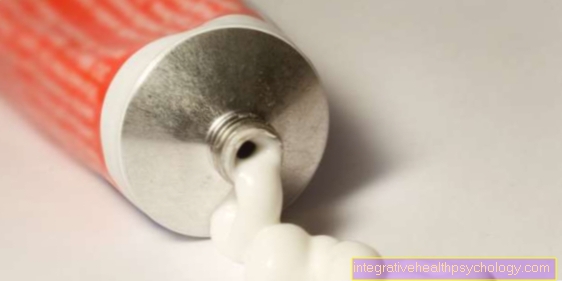Kidney biopsy
Definition - What is a kidney biopsy?
A kidney biopsy is a sample of tissue from one or both kidneys. The word kidney puncture is used synonymously. A kidney biopsy can reliably identify the cause of impaired kidney function. It is the gold standard, i.e. the diagnosis of choice, for unclear kidney function restrictions. This means that a suitable therapy plan can be created for the respective disease.

Indication for a kidney biopsy
In general, as for any other diagnostic measure, the indication for a kidney biopsy can be made if the diagnostic benefit is greater than the potential risk.
Indications for a kidney biopsy can include acute kidney failure, chronic kidney failure, systemic lupus erythematosus, blood in the urine (hematuria) or protein in the urine (proteinuria) with a suspicion of progressive kidney disease, changes in the kidney with a suspicion of cancer or but also problems after a kidney transplant.
Preparations for a kidney biopsy
The preparation before a kidney biopsy should always be done in consultation with the attending physician.
Basically, it should be ensured that anticoagulant drugs are discontinued in good time. It is important to discuss with the treating doctor when which medication should be discontinued and when it can be taken again after the procedure.
Furthermore, a blood test is usually carried out before a kidney biopsy. It is important to determine the blood coagulation and inflammation values.
A kidney biopsy is usually done under local anesthesia. Nevertheless, it is recommended to be sober during the procedure. This means that the last solid meal is usually consumed the evening before and only water or tea can be drunk up to around 4 hours before the procedure. Here, too, it is advisable to consult the doctor treated.
Is a kidney biopsy painful?
A kidney biopsy is usually not painful because the skin is numbed with a local anesthetic. The biopsy of the kidney itself does not hurt. If necessary, a somewhat uncomfortable feeling of pressure can arise during the biopsy.
If pain develops at the biopsy site after the biopsy, pain relievers such as paracetamol can be used. A kidney biopsy should not be followed by severe pain.
Aspirin should not be taken for three days after the biopsy, as this can lead to increased bleeding.
Is a kidney biopsy done under anesthesia?
Anesthesia is usually not necessary for a kidney biopsy. The skin, the tissue under the skin and the muscles are numbed with a local anesthetic. The kidney itself is not painful. This means that the procedure is not painful. If necessary, something can also be given to calm down. A kidney biopsy under anesthesia is therefore only performed in exceptional cases.
Can a kidney biopsy be performed on an outpatient basis?
A kidney biopsy cannot be performed on an outpatient basis. After the biopsy, the patient should be monitored for 24 hours. The first 6 hours after the procedure you should lie on your back on a sandbag to avoid bruising (hematomas). If the biopsy is uncomplicated, discharge usually takes place the following day. The day after the biopsy, the urine, blood values and an ultrasound of the kidney will also be checked.
14 days after the kidney biopsy, no heavy loads should be carried and no sport should be done
Results after a kidney biopsy
The biopsy is given to the pathology department. After about 24 hours there is a preliminary result. The final result can take up to 10 days if special sections have to be made. In urgent cases, a preliminary finding can be available within 3 hours.
The result of a kidney biopsy is particularly important for further therapy planning.
How long does it take to get the results?
Depending on which sections are made, the diagnosis takes different lengths of time. As a rule, a result can be expected within 3-5 days. Preliminary findings can often be made within 24 hours. If special sections are made, the final result can take 10 to 14 days.
Risks and side effects of a biopsy
The greatest risk after a kidney biopsy is causing bleeding from the kidney. It is therefore important to monitor the patient for 24 hours after a kidney biopsy. This means that the pulse and blood pressure are measured regularly, the biopsy site is checked regularly and the urine output is monitored. There is also bed rest to reduce the risk of bleeding. Placing a sandbag underneath can also minimize the risk of secondary bleeding.
Minor secondary bleeding is usually expressed in bruises (hematomas). If more blood is lost, a blood transfusion may be necessary. Postoperative bleeding only has to be treated surgically in extremely rare cases. It is extremely unlikely that a kidney will have to be removed due to rebleeding.
In 5% of patients, the urine turns red after a kidney biopsy. Often the red color is self-limiting and the urine becomes clear again without further measures. Otherwise an irrigation catheter is applied.
Furthermore, there may be an intolerance to the local anesthetic. General risks such as infections or injuries to surrounding structures also exist with a kidney biopsy. Adequate skin disinfection and a puncture under ultrasound control, however, minimize the risks.
Blood in the urine
A slight red coloration of the urine after a biopsy occurs in 5% of patients. It is important to ensure that the red color decreases and does not become stronger. As a rule, the red colouration stops by itself. If the blood turns red, the blood values should be checked and an ultrasound check carried out again to rule out secondary bleeding. If necessary, an irrigation catheter is applied. In rare cases, blood transfusions may also be necessary.
How long does a kidney biopsy take?
The kidney biopsy itself only takes a few seconds. However, due to the positioning on the stomach and sufficient skin disinfection, about 20 minutes should be expected for the procedure. After a biopsy, bed rest should be kept for 24 hours.
What does a kidney biopsy cost?
A kidney biopsy is billed according to the doctor's fee schedule. It is in the 3 to 4-digit range.
Who pays for a kidney biopsy?
Since a kidney biopsy is only performed by a doctor if indicated, the health insurance company bears the costs of a kidney biopsy.
What alternatives are there?
A kidney biopsy is the only method to reliably identify the cause of a kidney impairment. Most of the time, the biopsy is performed under ultrasound guidance. Alternatively, biopsies can be performed under CT control or laparoscopically (minimally invasive). There is no alternative to a reliable diagnosis.
If you do not want to have a biopsy performed, an ultrasound examination, a CT or MRI, a urine or blood test can provide clues as to the cause of an unclear kidney function impairment.
Read more on the subject at: MRI of the kidney





























